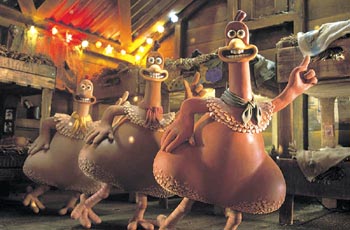![[Metroactive Dining]](/dining/gifs/dining468.gif)
[ Dining Index | Santa Cruz Week | SantaCruz Home | Archives ]
Pets or Meat?
Santa Cruz takes a leading role in the chicken rescue movement
By Elisa Camahort
Have you seen the Carl's Jr. chicken-sandwich ads? You know, the one where they taunt a chicken because it can't "sit" or "juggle" and then conclude with the tag line "There's only one thing a chicken's good for: eating."
It may surprise you to know that chickens make fine pets. They come when called. They follow around their humans. They like to be held and petted. They jump on shoulders. In Santa Cruz, there's a Pet Chicken Meet-up group with more than 50 members. Chicken owners say their chickens are as intelligent as their other, more traditional pets, and that they're even friendlier than their cats.
I spent some time talking to one of those members, Cheryl Potter. Cheryl not only has dozens of pet chickens of her own, but recently pitched in to help with a large-scale battery chicken rescue in Gilroy, organized by the Animal Place (www.animalplace.org). Cheryl has taken in more than 100 chickens, cleaned them up and had them tested and treated by vets, and is quite successfully finding homes for them everywhere from Sacramento to Monterey.
What are battery chickens, and why did they need to be rescued? These are the chickens that lay our eggs. And while you may have visions of hens happily pecking about a farmyard clucking in your head, the harsh truth is that most eggs are laid by debeaked chickens packed in cages that they can't stand or turn around in. They are piled high, with the feces from the chickens in cages above them dripping down on the chickens below. Everything is automated, from food and water to egg collection, so no human ever has to go in and be overpowered by the noise or smell. And then after 1 1/2 to two years, hens kept in this condition are considered "spent" and sent to slaughter.
By the way, once they leave the battery cage, what few regulations there are about humane treatment (and you have to question what kind of teeth are in such regulations once you see how the hens that are covered by the regulations are treated) no longer apply. Yes, the poultry industry got a specific exemption from "humane treatment" for "spent hens."
Cheryl is just one of many people who helped save almost 1,800 chickens in one week. Kim Sturla from the Animal Place listed numerous humane societies, animal control agencies and especially the Center for Animal Protection and Education (www.capeanimals.org) as being critical to the rescue effort's success. They also needed people who don't work for or volunteer for those organizations to ensure a successful end to the endeavor. They needed people to provide foster homes to the chickens, like Cheryl did, and they needed people to take the chickens in permanently. Lots of people.
They got them. The Animal Place has been swamped with calls. Cheryl has found homes for over 250 chickens. The Internet was a big help, as she posted to vegetarian groups and sent the word out via meet-up groups, message boards, Craigslist.com and a site called backyardchickens.com.
I asked Cheryl if she considered herself to be an "activist." She doesn't see herself that way. She believes her vegetarianism is a personal choice, not one she'd push on anyone else. Cheryl also believes, though, that animals should be humanely treated, and she encourages people to at least buy humanely raised animals.
She has made certain lifestyle choices, and she's happy to tell people about them, but she is not out there leading an activist life. But she hastens to add: "It doesn't take an animal rights activist to say, 'This is wrong.' I think the average American would think it was disgusting and totally wrong if they could see how these chickens were treated."
I know people who travel overseas and return with horrified stories about being offered horse or dog meat. Clearly different cultures have drawn the "cute" line in different places, but if you talk to nontraditional pet owners, those with everything from poultry to pigs (pot-bellied or not) will tell you these are artificial lines, and that all of these animals are "good for" a whole lot more than eating.
Copyright © 2005 Metro Publishing Inc. Maintained by Boulevards New Media.
For more information about Santa Cruz, visit santacruz.com.
![]()

Fowl Play: The stars of 'Chicken Run' have it much better than their real-life counterparts.
From the September 28-October 5, 2005 issue of Metro Santa Cruz.